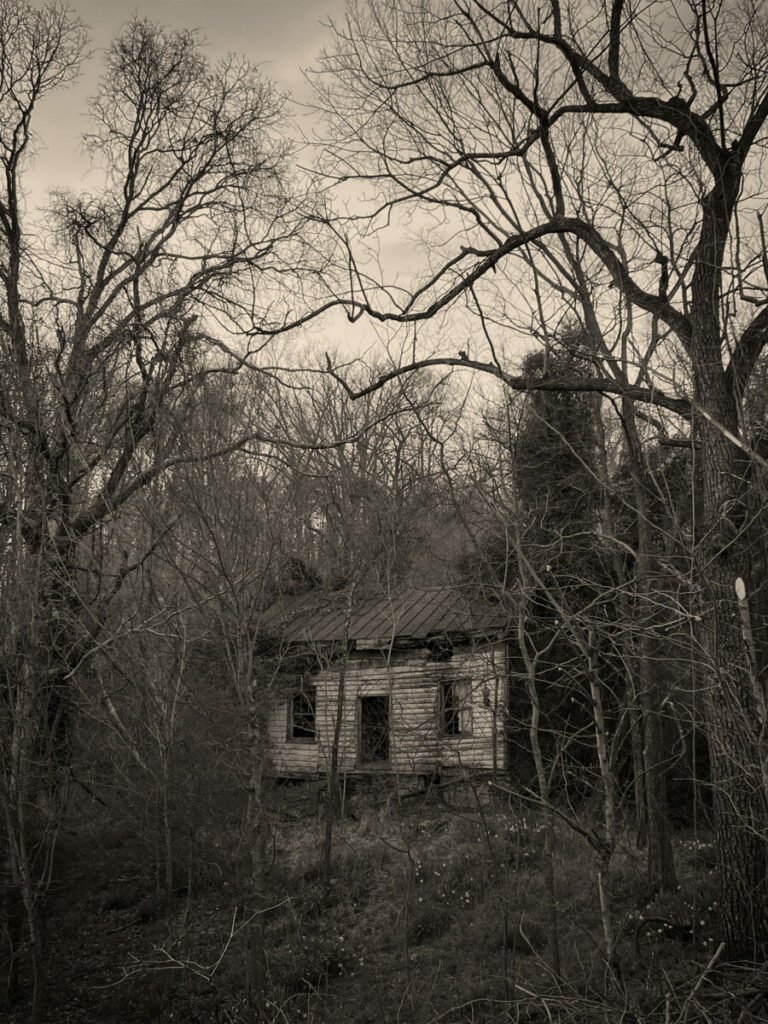Not too long ago, I was walking my black lab down Norwood Road when an acquaintance stopped his truck to chat. He said he was concerned about my neighborhood. Wasn’t I embarrassed for writers to come to the retreat and see all these ruined and abandoned houses here in Norwood? It’s a shame. It hurts him every time he passes through our hamlet, he said. He then announced that he was going to buy up as many of the forlorn houses as he could (he has the means) and renovate and turn them into Airbnbs. He was going to fix Norwood for us.
“Oh, no,” I said, hiding my dismay as much as politely possible, “writers love all the ruin and abandonment here. You don’t understand writers. It’s a different kind of aesthetic. It’s poetic. They love to write about these falling down, abandoned houses and graveyards.”
We were not far away from a two-story clapboard house, Granny Kidd’s. No telling how many years have passed since Granny died. I was not living here then. The missing glass panes of a window, a splintered board hangs, a piece of curtain. The house’s metal roof rusted, clapboard weathered gray and warped. The front porch boards missing. The thought of this beautiful ruin becoming a freshly painted gussied-up pop-up hotel?
We said good-bye and I continued my walk. Not far from the Tye River bridge are the steps to the old graveyard, a roadside attraction of abandonment.
Writer Alex Joyner once shared a piece inspired by this graveyard:
A concrete slab is all that keeps T. B. Denton from spilling into the intersection of 655 & 626 by the Tye River bridge in Norwood. He’s been planted there in sight of the Tye for a century now but mountainsides roll down, slowly or suddenly, and the concrete is a stop gap measure to prevent T. B.’s further demise.
I have passed the twenty-four steps to the Denton Graveyard many times on my walks around Norwood. They have intrigued me. Steps to nowhere, they seem. Leaf-strewn and neglected. If you didn’t allow your eyes to adjust to see the wrought-iron fence above you’d think they were the relic of a long-past estate. A stairway to oblivion. Which perhaps they are.
A painted piece of particle board—white cross on a black background, splinters tearing at the art—nestles against a tree trunk by the stairs. The only hint of what might greet the intrepid visitor.
I climbed the stairs because I had exhausted the other enticements in this sector over my infrequent visits. The plastic chair by the old mill house down on the river? Been there. Done that. The track that leads to the merger of the Tye with the mighty James? Yep. The abandoned Episcopal church, which cuts a stark profile against any sky? Yes. The railroad bridge? The cutover field? The remains of the Kanawha Canal? Yes, yes, and yes.
So it’s settled. A quick trip up the steps it is. It certainly requires less time and exertion than another trip to the James. And who knows what stories lay buried up there?
The plot is roughly twelve by twelve. Boxwoods line the edge of the fence—Virginia’s ubiquitous colonial plant forever nodding to an English past. One of them has sneaked over the wrought iron and grown into a tall tree that overshadows the graves. Only two souls to shade.
A frayed blue bungee cord, shorn of its hooks on either end, is knotted through the gate where once it had a lock. The cord is easily untied and the gate swings open to let me in.
I am standing before two stones—highly conscious that it is very difficult not to be standing on the graves in this small space. Some parental voice from my childhood squawks in my head. Respect means ‘Don’t tread on the dead.’
T. B. had the more impressive monument. A three-foot engraved pillar of stone that not only marks his data (Jun 15, 1859—May 18, 1915) but his demeanor and destination:
His words were kindness
his deeds were love
his spirit humble
he rests above.
Fifty-five at death. I’m almost there. I don’t anticipate a marker like his. It’s a bit gaudy for my taste. But a similar encomium? Perhaps that.
To my right, a more familiar stone. Cora Wood Denton got only the dates (Feb. 5, 1875—Feb. 2, 1953) but a much longer life. How long had she spent with T. B. as his much younger wife? Twenty years? Twenty-five? Then the near forty years a widow awaiting this reunion.
Striated sunlight striped her name. The old river ran deep and green. A strong breeze drove ripples against the current. A black F-150 drove by, never seeing me nor the Dentons. We could remain here for eons were it not for erosion and the inevitable tumble into dust.
They’re more fortified than most couples. They have an impressive plot with a view to die for. But things will rumble on and the Dentons and I will go the way of kindness, love, and humbleness. We’ll rest above while those who follow wonder why the hell they bothered to pour those stairs. Alex Joyner—25 March 2018, Norwood
End of story:
The well-meaning, yet benighted farmer-business man, did renovate one old house in Norwood and then, much to our relief, abandoned his mission to rid us of our ruins.


Share this post with your friends.

